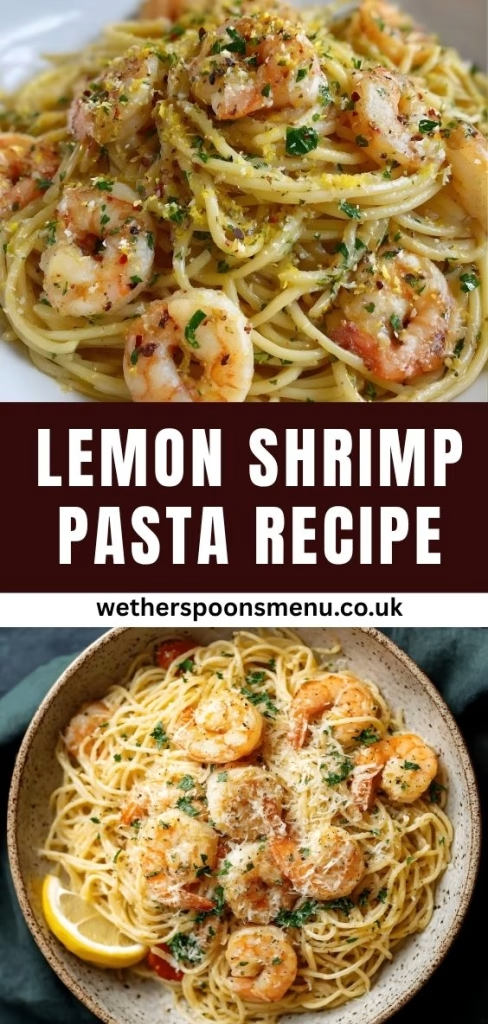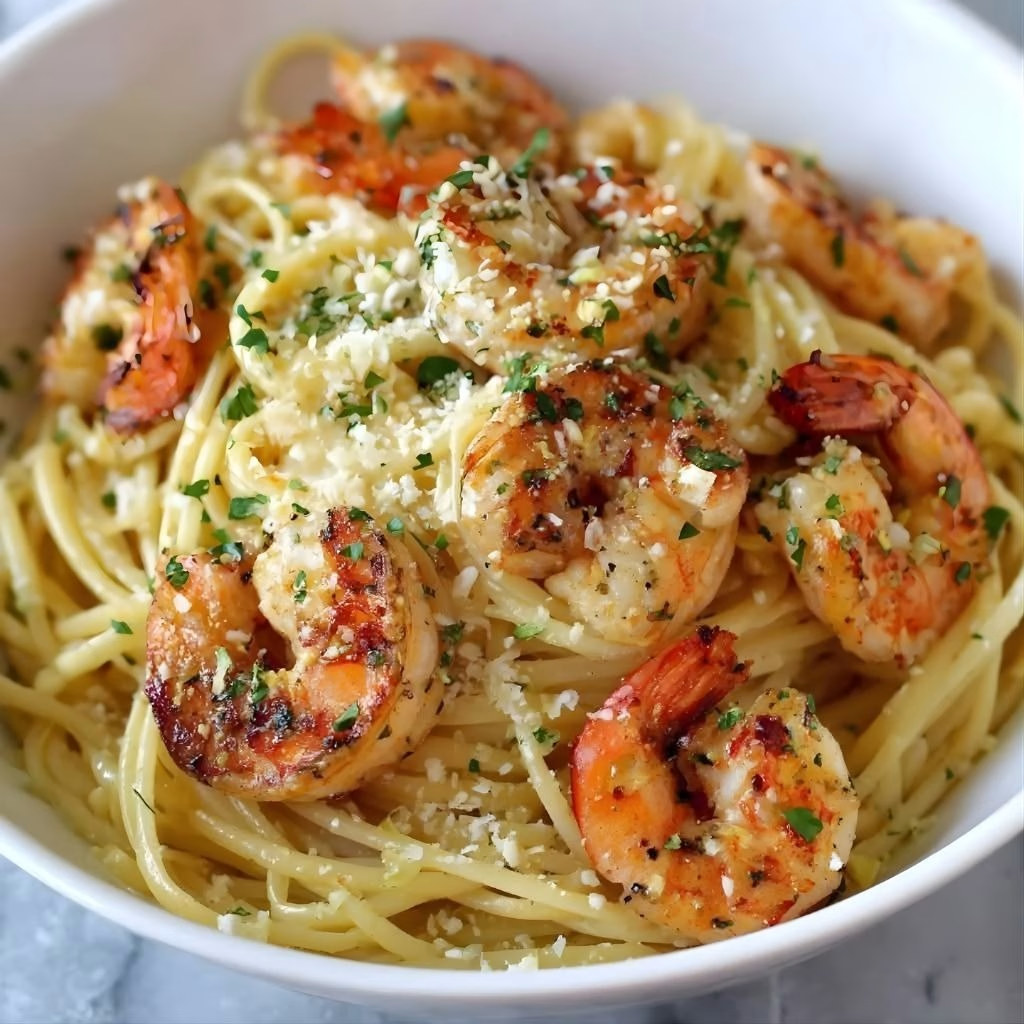Lemon Shrimp Pasta Recipe | Light & Zesty Flavorful Dinner
I made this Lemon Shrimp Pasta recipe the other night, and let me tell you — it instantly became one of my go-to weeknight meals. The shrimp turns beautifully plump, and the garlicky buttery sauce with lemon zest gives everything a bright, elegant lift. It feels kind of fancy — like something you’d make for guests — but it’s so simple and quick.
I couldn’t wait to share it with you, because once I tasted how perfectly the pasta, butter, and lemon come together, I knew I’d be making it again. You may also enjoy a cozy starter like Mac and Cheese Soup Recipe alongside this pasta for a creamy complement.

Ingredients
Here’s what you’ll need to make this dish perfectly, plus a few tips on why each ingredient matters:
- 1 lb (454 g) large shrimp (21/25 count) — using large, peeled and deveined shrimp helps them stay juicy and cook evenly.
- ½ teaspoon baking soda — this helps “brine” the shrimp briefly, making them plump and giving them better texture.
- ½ teaspoon kosher salt (Diamond Crystal, if you have it) — for that same brine bath.
- ¼ teaspoon black pepper — adds a gentle peppery warmth.
- ⅛ teaspoon crushed red pepper flakes — just a hint of heat to balance the lemon.
- ½ lb (227 g) spaghetti — the classic pasta for this sauce; using high-quality dried spaghetti gives a great bite.
- 4 tbsp (60 g) extra-virgin olive oil — for sautéing the shrimp gently and building flavor.
- 6 cloves garlic, sliced — garlic is the heart of the sauce; slicing (instead of mincing) gives a mellow garlicky bite.
- ~2 cups (480 g) reserved pasta water — this starchy water helps make the sauce emulsify and stick to the pasta.
- 4 tbsp (56 g) unsalted butter — the butter plus pasta water makes a rich, silky sauce.
- 1 large lemon, zested and juiced — the lemon zest brings fragrance; the juice brings acidity and freshness.
- ¼ cup (about 15 g) minced fresh flat-leaf Italian parsley — adds color, freshness, and a herbaceous note.
- Salt and additional pepper to taste — to finish the dish, because you want to balance flavors perfectly.
Note: several serving, this recipe makes about 4 servings.
Variations
If you want to put your own spin on this Lemon Garlic Shrimp Pasta, here are a few fun and practical tweaks:
- Dairy-free: Replace the butter with vegan buttery spread or a neutral plant-based fat, and use a splash more olive oil.
- Spicy: Increase the crushed red pepper flakes, or even add a pinch of cayenne for a stronger kick.
- Garlic-forward: If you love garlic, you can mince extra cloves instead of slicing, or roast them lightly first.
- Herb variation: Swap parsley with fresh basil or chives for a different herbaceous note.
- Lemon twist: Use half lime juice instead of lemon, or even preserved lemon for a more mellow, tangy citrus flavor.
- Pasta swap: Use linguine, fettuccine, or even gluten-free pasta if that’s what you have on hand. You might also pair it with a fun dessert like Fried Strawberry Cheesecake Sandwiches to end the meal sweetly.

Cooking Time
Here’s how long each part of this recipe takes:
- Prep Time: ~10 minutes
- Cooking Time: ~20 minutes
- Total Time: ~30 minutes
Equipment You Need
To make this recipe smoothly, here’s what I used (and why):
- Large pot — to boil the spaghetti.
- Large sauté pan — for cooking the shrimp, garlic, and making the sauce.
- Wooden spoon — helps scrape up flavor bits from the pan and toss the pasta.
- Citrus zester or microplane — to zest the lemon without too much pith.
- Knife and cutting board — for slicing garlic and chopping parsley.
- Measuring spoons — to measure salt, pepper, baking soda, and butter precisely.
How to Make Lemon Garlic Shrimp Pasta
Here’s how I make this dish, step by step:
Brine the Shrimp
I start by combining the shrimp with baking soda, kosher salt, black pepper, and crushed red pepper flakes in a bowl. I mix it gently and let it sit for about 10 minutes — this little brine helps keep the shrimp juicy and gives them great texture when cooked.
Prep Lemon, Garlic, and Pasta
While the shrimp brines, I zest and juice the lemon, slice the garlic, and mince the parsley. Then I bring a large, salted pot of water to a boil and cook the spaghetti to one minute less than al dente. I make sure to reserve at least a cup of the pasta water before draining.
Cook the Shrimp
Next, I heat a large pan over medium heat with the extra-virgin olive oil. Once it’s shimmering, I add the shrimp in a single layer and sauté for about 3–4 minutes, flipping halfway. It’s important not to overcrowd the pan, so each shrimp cooks evenly and becomes firm and opaque but not rubbery.
Make the Lemon-Garlic Sauce
When the shrimp is cooked, I remove them to a plate and tent them with foil to keep warm. Then, in the same pan, I add the sliced garlic, letting it sauté for 2–3 minutes until it’s golden and fragrant. If the pan seems dry, I drizzle in a little more olive oil.
Build the Pasta Dish
I pour in about ½ cup of the reserved pasta water, using a wooden spoon to scrape up the flavorful bits stuck to the bottom of the pan. Then I add the pasta and 4 tablespoons of butter, tossing for about a minute so everything emulsifies. If I can, I flip the pan to help the butter + pasta water cling to the noodles; if not, I stir very deliberately to coat well.
Bring It All Together
Finally, I add the shrimp back to the pan, along with the parsley, lemon juice, and lemon zest. I toss everything together, taste, and then adjust for salt, pepper, or more red pepper if needed. If the pasta seems a little dry, I loosen it with a splash more pasta water. Serve immediately for best texture and flavor.
Additional Tips for Making This Recipe Better
From my own experience making this over and over, here are a few tips that really help:
- I make sure to completely thaw the shrimp (if frozen) beforehand — it ensures even cooking.
- I always reserve more pasta water than I think I’ll need — the starchy water is magic for building sauce and rescuing dryness.
- When sautéing garlic, I watch it closely; once it just turns golden, I stop — overcooked garlic gets bitter.
- I don’t skimp on the lemon zest — the zest makes a huge difference in brightness.
- I serve it right away — the sauce is best fresh, and the shrimp texture is at its peak.
How to Serve Lemon Garlic Shrimp Pasta
To make this dish feel extra special when serving:
- Serve on warmed plates to keep the pasta from cooling too fast.
- Garnish with a little extra fresh parsley and maybe a twist of lemon zest right on top to make it look vibrant.
- Add lemon wedges on the side so guests (or you!) can squeeze a bit more citrus if desired.
- Pair it with a light salad (like an arugula-parmesan salad) or some crusty bread to soak up the buttery garlic sauce.

Nutritional Information
Here’s a rough estimate of the nutrition per serving (based on the original):
- Calories: ~561 kcal
- Protein: ~32.4 g
- Carbohydrates: ~32.8 g
- Fat: ~33.6 g
Make Ahead and Storage
Here’s how to manage leftovers or prep ahead:
Storage: After cooking, let the pasta cool, then transfer to an airtight container. It keeps well in the fridge for up to 3 days, though shrimp is best eaten sooner rather than later.
Reheating: When you’re ready to eat again, gently reheat on the stove with a splash of water or reserved pasta water to loosen up the sauce. Microwave works too, but go slow so the shrimp doesn’t overcook.
Freezing: I don’t recommend freezing this dish — the shrimp and the delicate butter-lemon sauce don’t always reheat well after being frozen. In my experience, textures change too much.
Why You’ll Love This Recipe
Here’s why this Lemon Garlic Shrimp Pasta is a real winner (at least in my kitchen):
- Easy & Quick: It comes together in about 30 minutes, making it perfect for a weeknight dinner or last-minute gathering.
- Impressively Elegant: Despite how simple it is, it tastes and looks restaurant-worthy — buttery, lemony, and garlicky.
- Versatile: You can tweak it with dietary preferences (dairy-free, spicy, extra garlic) without breaking the core flavors.
- Bright & Fresh Flavor: The combination of lemon zest and juice gives it a refreshing citrusy note that balances richness.
- Great Leftovers: While best fresh, it still reheats decently — perfect if you want to make extra.

Lemon Shrimp Pasta Recipe
Ingredients
Method
- I start by combining the shrimp with baking soda, kosher salt, black pepper, and crushed red pepper flakes in a bowl. I mix it gently and let it sit for about 10 minutes — this little brine helps keep the shrimp juicy and gives them great texture when cooked.
- While the shrimp brines, I zest and juice the lemon, slice the garlic, and mince the parsley. Then I bring a large, salted pot of water to a boil and cook the spaghetti to one minute less than al dente. I make sure to reserve at least a cup of the pasta water before draining.
- Next, I heat a large pan over medium heat with the extra-virgin olive oil. Once it’s shimmering, I add the shrimp in a single layer and sauté for about 3–4 minutes, flipping halfway. It’s important not to overcrowd the pan, so each shrimp cooks evenly and becomes firm and opaque but not rubbery.
- When the shrimp is cooked, I remove them to a plate and tent them with foil to keep warm. Then, in the same pan, I add the sliced garlic, letting it sauté for 2–3 minutes until it’s golden and fragrant. If the pan seems dry, I drizzle in a little more olive oil.
- I pour in about ½ cup of the reserved pasta water, using a wooden spoon to scrape up the flavorful bits stuck to the bottom of the pan. Then I add the pasta and 4 tablespoons of butter, tossing for about a minute so everything emulsifies. If I can, I flip the pan to help the butter + pasta water cling to the noodles; if not, I stir very deliberately to coat well.
- Finally, I add the shrimp back to the pan, along with the parsley, lemon juice, and lemon zest. I toss everything together, taste, and then adjust for salt, pepper, or more red pepper if needed. If the pasta seems a little dry, I loosen it with a splash more pasta water. Serve immediately for best texture and flavor.
Notes
- I make sure to completely thaw the shrimp (if frozen) beforehand — it ensures even cooking.
- I always reserve more pasta water than I think I’ll need — the starchy water is magic for building sauce and rescuing dryness.
- When sautéing garlic, I watch it closely; once it just turns golden, I stop — overcooked garlic gets bitter.
- I don’t skimp on the lemon zest — the zest makes a huge difference in brightness.
- I serve it right away — the sauce is best fresh, and the shrimp texture is at its peak.